Effect of Dopant Loading on the Structural and Catalytic Properties of Mn-Doped SrTiO3 Catalysts for Catalytic Soot Combustion
Abstract
:1. Introduction
2. Results and Discussion
3. Materials and Methods
3.1. Preparation of Catalyst
3.2. Catalysts Characterization
3.3. Catalytic Test
4. Conclusions
Acknowledgments
Author Contributions
Conflicts of Interest
References
- Fino, D.; Russo, N.; Saracco, G.; Specchia, V. The role of suprafacial oxygen in some perovskites for the catalytic combustion of soot. J. Catal. 2003, 217, 367–375. [Google Scholar] [CrossRef]
- US-EPA. Office of Transportation and Air Quality; EPA-420-F-00-100; US-EPA: Washington, DC, USA, 2000.
- Wang, Z.; Zhu, H.; Ai, L.; Liu, X.; Lv, M.; Wang, L.; Ma, Z.; Zhang, Z. Catalytic combustion of soot particulates over rare-earth substituted Ln2Sn2O7 pyrochlores (Ln = La, Nd and Sm). J. Colloid Interface Sci. 2016, 478, 209–216. [Google Scholar] [CrossRef] [PubMed]
- Hu, J.; Hu, Z.; Zhang, J.; Shuai, S. Effects of a catalyst on the nanostructure and reactivity of soot under an oxygen atmosphere. Energy Fuel 2016, 30, 2434–2442. [Google Scholar] [CrossRef]
- Liu, S.; Wu, X.; Weng, D.; Li, M.; Ran, R. Roles of acid sites on Pt/H-ZSM5 catalyst in catalytic oxidation of diesel soot. ACS Catal. 2015, 5, 909–919. [Google Scholar] [CrossRef]
- Liu, S.; Wu, X.; Weng, D.; Ran, R. NOx-assisted soot oxidation on Pt-Mg/Al2O3 catalysts: Magnesium precursor, Pt particle size, and Pt-Mg interaction. Ind. Eng. Chem. Res. 2012, 51, 2271–2279. [Google Scholar]
- Ura, B.; Trawzcynski, J.; Kotarba, A.; Bieniasz, W.; Illan-Gomez, M.J.; Bueno-Lopez, A.; Lopez-Suarez, F.E. Effect of potassium addition on catalytic activity of SrTiO3 catalyst for diesel soot combustion. Appl. Catal. B 2011, 101, 169–175. [Google Scholar] [CrossRef]
- Lopez-Suarez, F.E.; Bueno-Lopez, A.; Illan-Gomez, M.J.; Adamski, A.; Ura, B.; Trawczynski, J. Copper catalysts for soot oxidation: Alumina versus perovskite supports. Environ. Sci. Technol. 2008, 42, 7670–7675. [Google Scholar] [CrossRef] [PubMed]
- Lopez-Suarez, F.E.; Parres-Esclapez, S.; Bueno-Lopez, A.; Illan-Gomez, M.J.; Ura, B.; Trawczynski, J. Role of Surface and lattice copper species in copper-containing (Mg/Sr)TiO3 peroskite catalysts for soot combustion. Appl. Catal. B 2009, 93, 82–89. [Google Scholar] [CrossRef]
- Feng, N.; Wu, Y.; Meng, J.; Chen, C.; Wang, L.; Wan, H.; Guan, G. Catalytic combustion of soot over Ce and Co substituted three-dimensionally ordered macroporous La1−xCeXFe1−yCoxO3 perovskite catalysts. RSC Adv. 2015, 5, 91609–91618. [Google Scholar] [CrossRef]
- Feng, N.; Meng, J.; Wu, Y.; Chen, C.; Wang, L.; Gao, L.; Wan, H.; Guan, G. KNO3 supported on three-dimensionally ordered macroporous La0.8Ce0.2Mn1−xFeXO3 for soot removal. Catal. Sci. Technol. 2016, 6, 2930–2941. [Google Scholar] [CrossRef]
- Pecchi, G.; Dinamarca, R.; Campos, C.M.; Garcia, X.; Jimenez, R.; Fierro, J.L. Soot oxidation on silver-substituted LaMn0.9Co0.1O3 perovskites. Ind. Eng. Chem. Res. 2014, 53, 10090–10096. [Google Scholar] [CrossRef]
- Hernandez, W.Y.; Tsampas, M.N.; Zhao, C.; Boreave, A.; Bosselet, F.; Vernoux, P. La/Sr-based perovskites as soot oxidation catalysts for gasoline particulate filters. Catal. Today 2015, 258, 525–534. [Google Scholar] [CrossRef]
- Dhakad, M.; Rayalu, S.S.; Kumar, R.; Doggali, P.; Bakardjieva, S.; Subrt, J.; Mitsubishi, T.; Haneda, H.; Labhsetwar, N. Low cost, ceria promoted perovskite type catalysts for diesel soot oxidation. Catal. Lett. 2008, 121, 137–143. [Google Scholar] [CrossRef]
- Kim, C.; Qi, G.; Dahlberg, K.; Li, W. Strontium-doped perovskites rival platinum catalysts for treating NOx in simulated diesel exhaust. Science 2010, 327, 1624–1627. [Google Scholar] [CrossRef] [PubMed]
- Shao, W.; Wang, Z.; Zhang, X.; Wang, L.; Ma, Z.; Li, Q.; Zhang, Z. Promotion effects of cesium on perovskite oxides for catalytic soot combustion. Catal. Lett. 2016, 146, 1397–1407. [Google Scholar] [CrossRef]
- Sun, X.; Lin, J. Synergetic effects of thermal and photo-catalysis in purification of dye water over SrTi1−xMnxO3 solid solutions. J. Phys. Chem. C 2009, 113, 4970–4975. [Google Scholar] [CrossRef]
- Wu, G.; Li, P.; Xu, D.; Luo, B.; Hong, Y.; Shi, W.; Liu, C. Hydrothermal synthesis and visible-light-driven photocatalytic degradation for tetracycline of Mn-doped SrTiO3 nanocubes. Appl. Surf. Sci. 2015, 333, 39–47. [Google Scholar] [CrossRef]
- Giroir-Fendler, A.; Gil, S.; Baylet, A. (La0.8A0.2)MnO3 (A = Sr,K) perovskite catalysts for NO and C10H22 oxidation and selective reduction of NO by C10H22. Chin. J. Catal. 2014, 35, 1299–1304. [Google Scholar] [CrossRef]
- Peña, M.A.; Fierro, J.L.G. Chemical structures and performance of perovskites oxides. Chem. Rev. 2001, 101, 1981–2017. [Google Scholar] [CrossRef] [PubMed]
- Zhang, L.; Nie, Y.; Hu, C.; Qu, J. Enhanced fenton degradation of Rhodamine B over nanoscaled Cu-doped LaTiO3 perovskite. J. Appl. Catal. B 2012, 125, 418–424. [Google Scholar] [CrossRef]
- Lopez-Suarez, F.E.; Bueno-Lopez, A.; Illan-Gomez, M.J.; Trawczynski, J. Potassium-copper perovskite catalysts for mild temperature diesel soot combustion. Appl. Catal. A 2014, 485, 214–221. [Google Scholar] [CrossRef]
- Lencka, M.M.; Riman, R.E. Thermodynamic modeling of hydrothermal synthesis of ceramic powders. Chem. Mater. 1993, 5, 61–70. [Google Scholar] [CrossRef]
- Suárez-Vázquez, S.I.; Gil, S.; García-Vargas, J.M.; Cruz-López, A.; Giroir-Fendler, A. Catalytic oxidation of toluene by SrTi1−xBxO3 (B = Cu and Mn) with dendritic morphology synthesized by one pot hydrothermal route. Appl. Catal. B 2018, 223, 201–208. [Google Scholar] [CrossRef]
- Kalyani, V.; Vasile, B.S.; Ianculescu, A.; Testino, A.; Carino, A.; Buscaglia, M.T.; Buscaglia, V.; Nanni, P. Hydrothermal synthesis of SrTiO3: Role of interfaces. Cryst. Growth Des. 2015, 15, 5712–5725. [Google Scholar] [CrossRef]
- Liu, Y.; Dai, H.; Du, Y.; Deng, J.; Zhang, L.; Zao, Z.; Au, C.T. Controlled preparation and high catalytic performance of three-dimensionally ordered macroporous LaMnO3 with nanovoid skeletons for the combustion of toluene. J. Catal. 2012, 287, 149–160. [Google Scholar] [CrossRef]
- Lin, X.; Li, S.; He, H.; Wu, Z.; Wu, J.; Chen, L.; Ye, D. Evolution of oxygen vacancies in MnOx-CeO2 mixed oxides for soot oxidation. Appl. Catal. B 2018, 223, 91–102. [Google Scholar] [CrossRef]
- Giroir-Fendler, A.; Alves-Fortunato, M.; Richard, M.; Wang, C.; Díaz, J.A.; Gil, S.; Zhang, C.; Can, F.; Bion, N.; Guo, Y. Synthesis of oxide supported LaMnO3 perovskites to enhance yields in toluene combustion. Appl. Catal. B 2016, 180, 29–37. [Google Scholar] [CrossRef]
- Fang, S.; Wang, L.; Sun, Z.; Feng, N.; Shen, C.; Lin, P.; Wan, H.; Guan, G. Catalytic removal of diesel soot particulates over K and Mg substituted La1−xKxCo1−yMgyO3 perovskite oxides. Catal. Commun. 2014, 49, 15–19. [Google Scholar] [CrossRef]
- Han, X.; Wang, Y.; Hao, H.; Guo, R.; Hu, Y.; Jiang, W. Ce1−xLaxOy solid solution prepared from mixed rare earth chloride for soot oxidation. J. Rare Earth 2016, 34, 590–596. [Google Scholar] [CrossRef]
- Xiao, P.; Zhong, L.; Zhu, J.; Hong, J.; Li, J.; Li, H.; Zhu, Y. CO and soot oxidation over macroporous perovskite LaFeO3. Catal. Today 2015, 258, 660–667. [Google Scholar] [CrossRef]
- Lee, C.; Jeon, Y.; Hata, S.; Park, J.; Akiyoshi, R.; Saito, H.; Teraoka, Y.; Shul, Y.; Einaga, H. Three-dimensional arrangements of perovskite-type oxide nano-fiber webs for effective soot oxidation. Appl. Catal. B 2016, 191, 157–164. [Google Scholar] [CrossRef]
- Kissinger, H.E. Reaction kinetics in differential thermal analysis. Anal. Chem. 1957, 29, 1702–1706. [Google Scholar] [CrossRef]
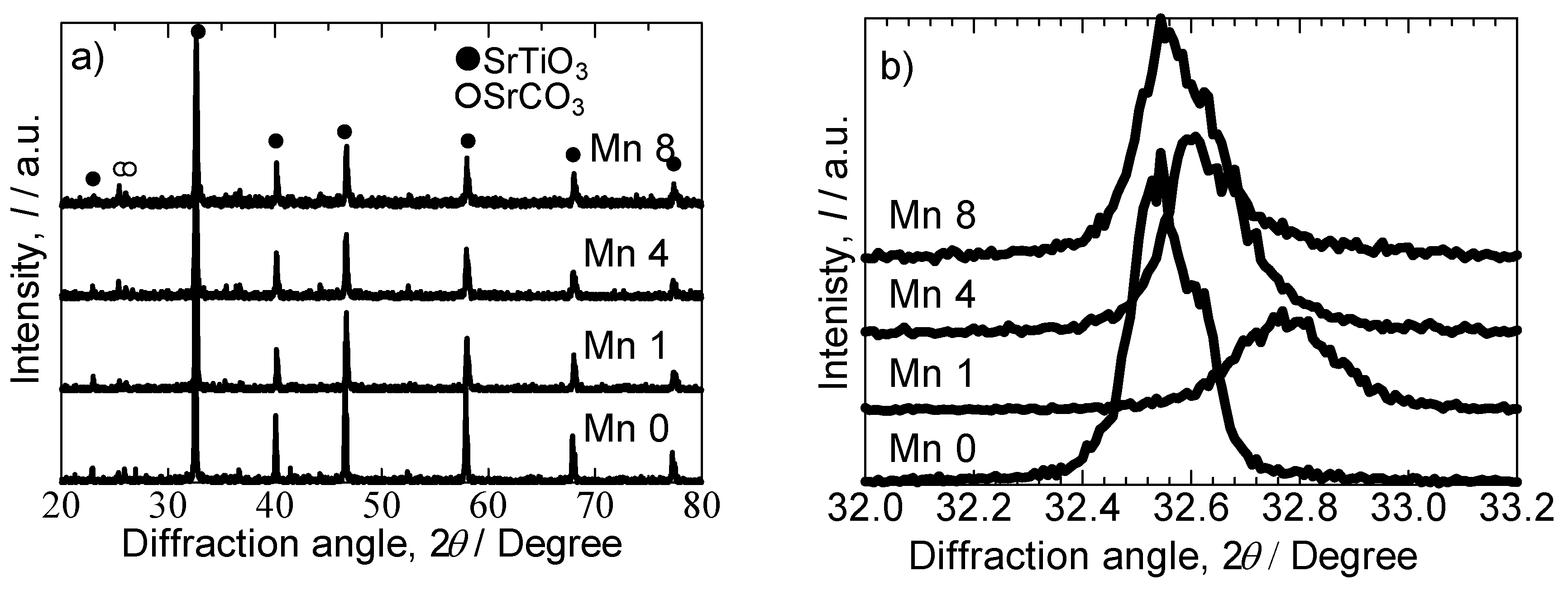
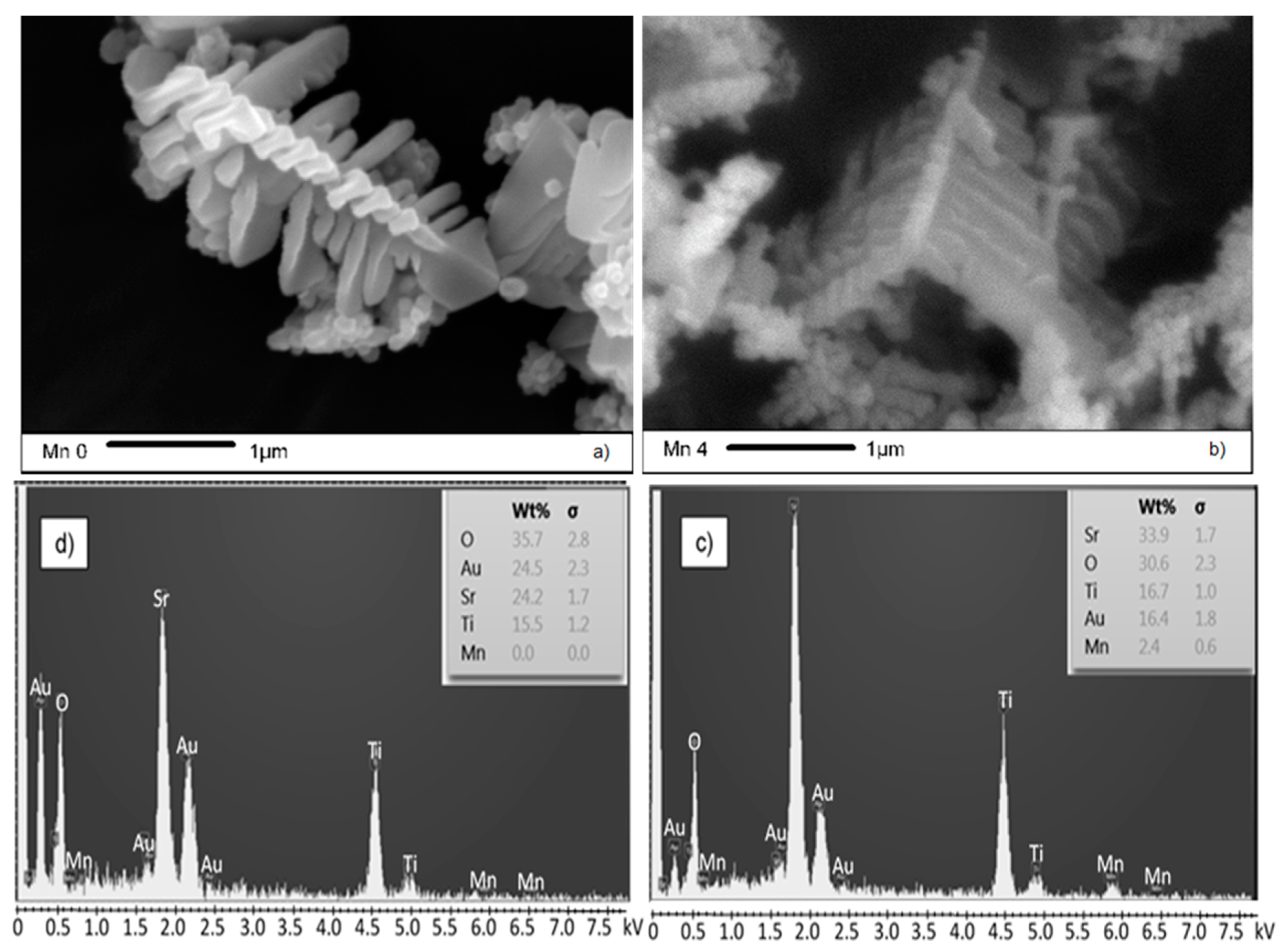
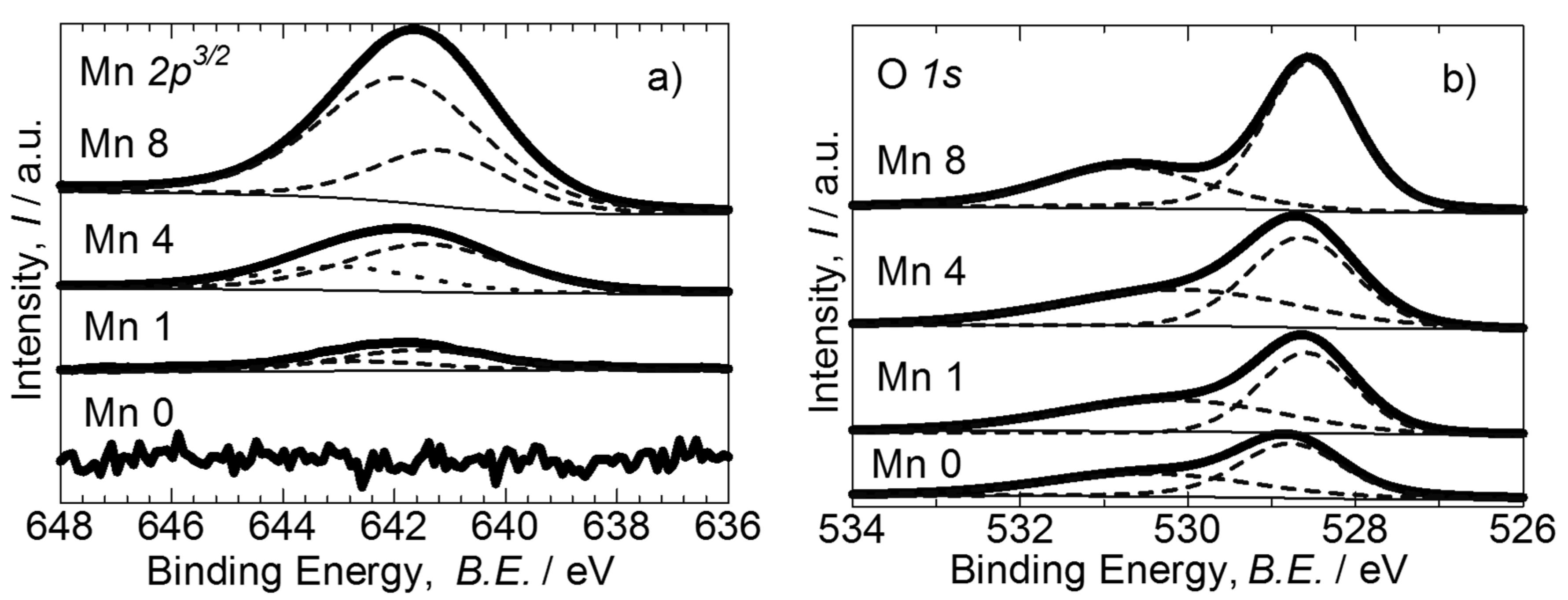
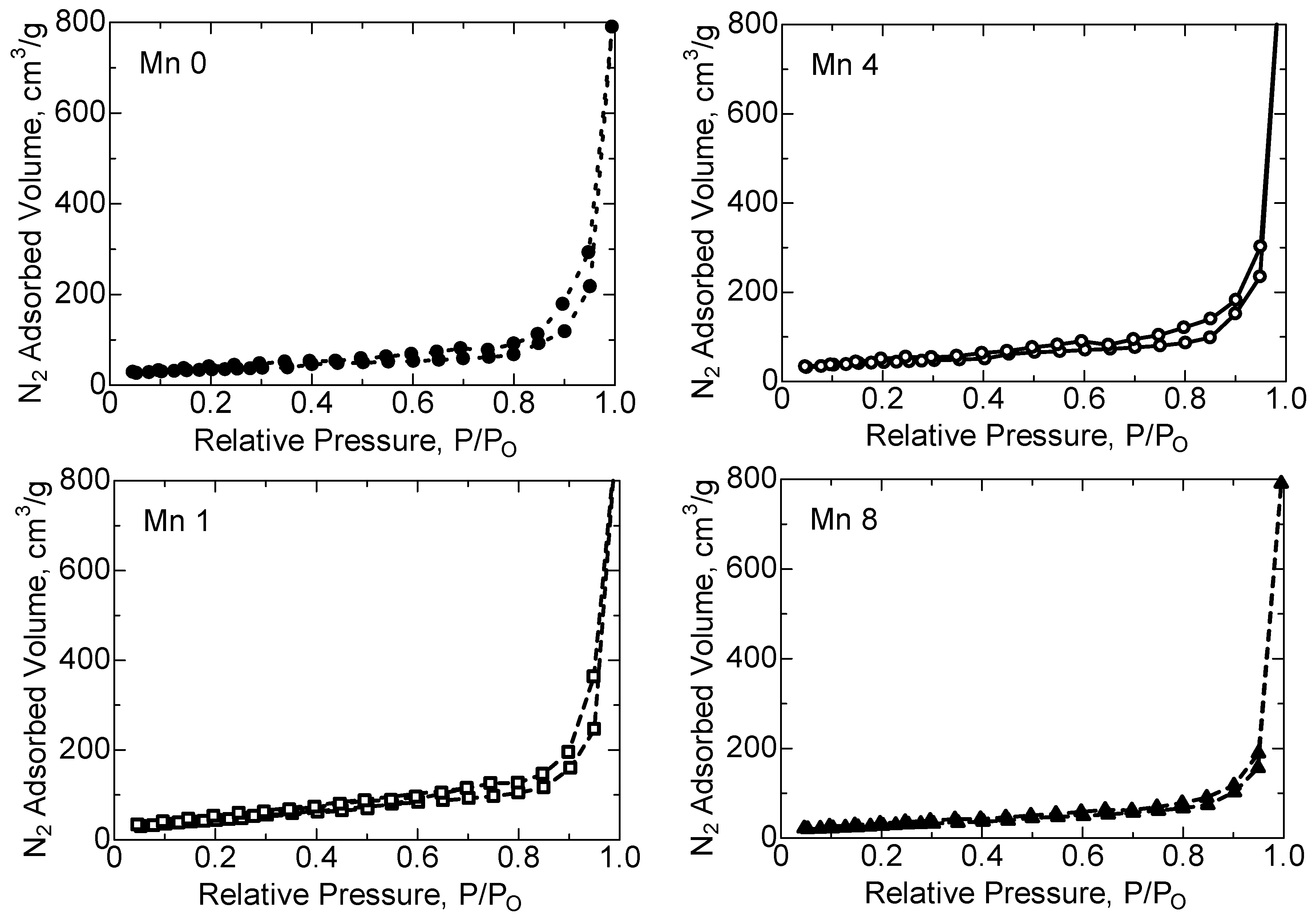

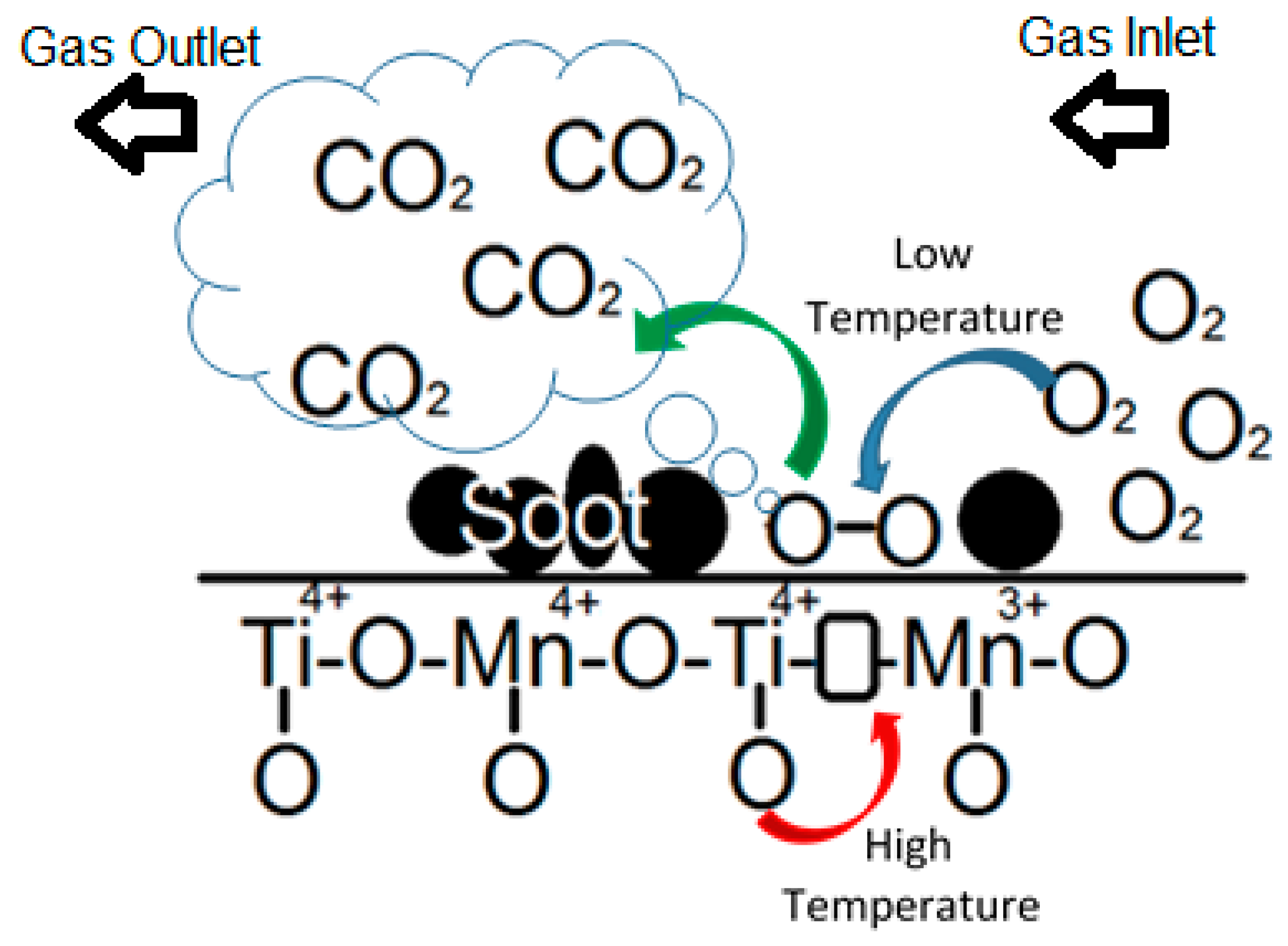
| Sample | Crystallite Size (nm) | Mn (wt %) | Lattice Parameter (Å) |
|---|---|---|---|
| Mn0 | 63.7 | 0.09 ± 0.07 | 3.886 |
| Mn1 | 39.5 | 1.97 ± 0.05 | 3.862 |
| Mn4 | 54.1 | 4.26 ± 0.02 | 3.881 |
| Mn8 | 53.8 | 8.98 ± 0.05 | 3.887 |
| Sample | Mean Pore Size (nm) | Pore Volume (cm3∙g−1) | Surface Area (m2∙g−1) | Oads/Olat | Mn3+/Mn4+ |
|---|---|---|---|---|---|
| Mn0 | 41.9 | 0.123 | 11.7 | 0.84 | - |
| Mn1 | 32.3 | 0.140 | 17.4 | 0.94 | 2.30 |
| Mn4 | 42.5 | 0.156 | 14.6 | 0.89 | 2.15 |
| Mn8 | 46.8 | 0.123 | 10.9 | 0.48 | 3.09 * |
| Sample | Tm (°C) | Ea (kJ∙K−1∙mol−1) |
|---|---|---|
| Uncatalyzed | 700 | 133.45 |
| Mn0 | 617 | 109.01 |
| Mn1 | 591 | 87.28 |
| Mn4 | 605 | 102.97 |
| Mn8 | 614 | - |
© 2018 by the authors. Licensee MDPI, Basel, Switzerland. This article is an open access article distributed under the terms and conditions of the Creative Commons Attribution (CC BY) license (http://creativecommons.org/licenses/by/4.0/).
Share and Cite
Suárez-Vázquez, S.I.; Cruz-López, A.; Molina-Guerrero, C.E.; Sánchez-Vázquez, A.I.; Macías-Sotelo, C. Effect of Dopant Loading on the Structural and Catalytic Properties of Mn-Doped SrTiO3 Catalysts for Catalytic Soot Combustion. Catalysts 2018, 8, 71. https://doi.org/10.3390/catal8020071
Suárez-Vázquez SI, Cruz-López A, Molina-Guerrero CE, Sánchez-Vázquez AI, Macías-Sotelo C. Effect of Dopant Loading on the Structural and Catalytic Properties of Mn-Doped SrTiO3 Catalysts for Catalytic Soot Combustion. Catalysts. 2018; 8(2):71. https://doi.org/10.3390/catal8020071
Chicago/Turabian StyleSuárez-Vázquez, Santiago Iván, Arquímedes Cruz-López, Carlos Eduardo Molina-Guerrero, Astrid Iriana Sánchez-Vázquez, and Carlos Macías-Sotelo. 2018. "Effect of Dopant Loading on the Structural and Catalytic Properties of Mn-Doped SrTiO3 Catalysts for Catalytic Soot Combustion" Catalysts 8, no. 2: 71. https://doi.org/10.3390/catal8020071





